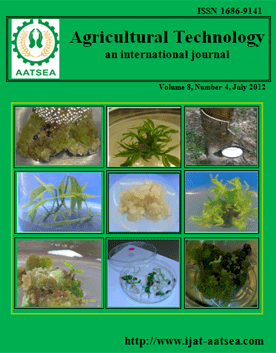ThaiScience
ThaiScience
INTERNATIONAL JOURNAL OF AGRICULTURAL TECHNOLOGY
Volume 14, No. 07, Month DECEMBER, Year 2018, Pages 1243 - 1258
Effects of oil enriched diets on growth, feed conversion ratio and fatty acid content of nile tilapia (oreochromis niloticus) in biofloc system
Inkam, M., Whangchai, N., Tongsiri, S. and Sompong, U.
Abstract Download PDF
The effect of oil enriched diets to increase omega-3 fatty acids in the flesh of Nile tilapia (Oreochromis niloticus) by biofloc technology (BFT) system cultivation was investigated. Six feed diets containing 30% protein were added with different types of oil; control diet added with soybean oil, feed diet added with fish oil (FO), feed diet added with fish oil and soybean oil 1:1 (FO:SO), feed diet added with lard oil (LO), feed diet added with lard oil and soybean oil 1:1 (LO:SO) and feed diet added with fish oil and lard oil 1:1 (FO:LO). Each treatment was done in triplicate. Nile tilapia (initial weight 30±1.20 g) larvae were cultured in glass tanks and reared for 8 weeks. Tilapia fed with FO diet showed highest growth and weight gain (62.7±0.18 g) (p>0.05). However, there were no differences in the survival rate (95-97%) and feed conversion ratio in every treatment (1.4- 1.5) (p>0.05). The fatty acids profile of flesh fed with 6 oil supplemented diets was studied. Fatty acid composition of FO was highest in total omega-3 (21.49%), followed by LO:SO (11.28%). FO treatment had the highest total omega-6 (52.78%), followed by control treatment (46.94%). This study demonstrated the efficacy of omega-3 fatty acids supplementation of fish fed in biofloc system that could be meet commercially valuable in the future.
Keywords
Biofloc, Nile tilapia, Omega-3 fatty acidINTERNATIONAL JOURNAL OF AGRICULTURAL TECHNOLOGY
Published by : Association of Agricultural Technology in Southeast Asia (AATSEA)
Contributions welcome at : http://www.ijat-aatsea.com
